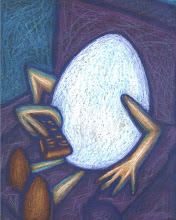Stairway to...
Stairway to the Sky
This image reminds me of the song "Stairway to Heaven" which has been written up as one of the most famous and popular songs in music history. There's all kinds of trivia on the internet about the song since it is so famous. My favorite trivia is when the lyrics for the song appeared in a book titled, "'Scuse Me While I Kiss This Guy: And Other Misheard Lyrics by Gavin Edwards and Chris Kalb." They claim we've always heard the lyrics as "...and there's a wino down the road. I should have stole more oreos." when in fact what Led Zepplin is really singing is, "and as we wind on down the road, our shadow longer than our souls." Much deeper, right?
I wasn't thinking of this song at all when I created the image, though. I wasn't feeling very spiritual or melancholy, either. I was simply frustrated with my students for not getting a perspective assignment correct. I created this as an example of how a stairway in the sky would look in perspective. Linear and atmospheric perspective are both used here to form the illusion of something trailing off into deep space.
In linear perspective all horizontal angles converge at a vanishing point which rests on the horizon. (that's really a traditional textbook definition) The horizon line (where the earth meets the sky) can be below the viewer's eye, even with the viewer's eye or above the viewer's eye like this image portrays.
Atmospheric or aerial perspective occurs when we stare out at the horizon and the detail of all the objects becomes blurry as if the atmosphere is absorbing the earth. (Which it is. We are viewing the curvature of the earth so we see the bottom layer of clouds obliterating the landscape)
Both of these devices, when used correctly, can give the viewer a deep sense of space.
This is important for 2-D artists because as illustrators of a concept, we must create the illusion of the third dimension. Our greatest challenge is that flat, picture plane and white canvas.
This image is available on ebay:
http://www.ebay.com/itm/261545482568?ssPageName=STRK:MESELX:IT&_trksid=p3984.m1555.l2649


























